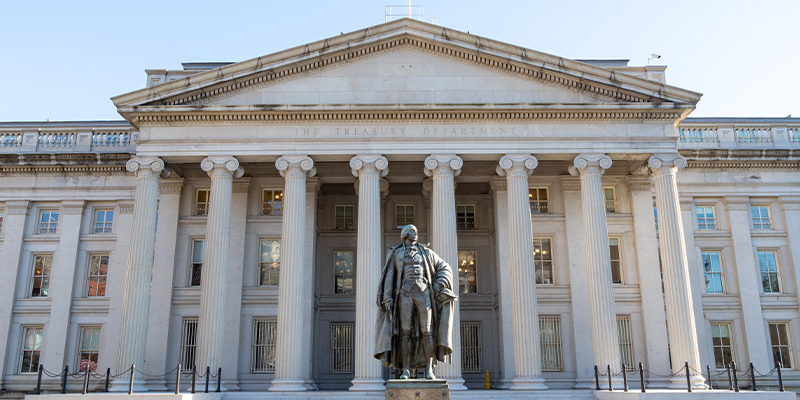The federal government has provided additional support for state and local governments in response to the COVID-19 pandemic. President Joe Biden signed the American Rescue Plan Act (ARP) into law on March 11, which established the Coronavirus State and Local Fiscal Recovery Funds. The new federal funds provide $350 billion to support state, local, territorial, and tribal governments in responding to the COVID-19 pandemic and spurring economic growth. These federal funds are a windfall for some governments that did not experience a fiscal shortfall, particularly at the state level.
State and local governments will receive the following amounts:
| Level of Government | Total (billions) |
|---|---|
| States and the District of Columbia | $195.3 |
| Counties | $65.1 |
| Metropolitan Cities | $45.6 |
| Tribal Governments | $20.0 |
| Territories | $4.5 |
| Local Non-entitlement Governments (Townships) | $19.5 |
The U.S. Treasury Department is overseeing the enactment of the new act and is responsible for the distribution of the ARP funds to the eligible units of state and local government. The department published an interim final rule on May 17, 2021, that is intended to meet the following objectives:
- Support the response of state, local and tribal governments to the pandemic.
- Replace lost revenue of eligible units of government and sustain jobs.
- Provide support to households and businesses impacted by the pandemic.
- Address the public health and economic challenges created by the pandemic.
The Treasury Department has also issued a Frequently Asked Questions (FAQ) document to accompany the interim rule in order to further assist state and local governments in the appropriate usages of the federal funds within their jurisdictions.
The comment period concluded on July 16 with many state and local associations submitting their views or interpretations of the interim final rule. The National Association of Counties (NACo) was one of these associations. Their comments called for “flexibility, transparency and accountability of any federal aid.” NACo also asked for clarification and the expansion of eligible local capital investment projects beyond water, sewer and broadband. The Treasury Department will review and take into consideration these and other submitted comments in publishing the final ARP rule.
The absence of a final rule has not held up the distribution of ARP funds to state and local governments. Federal department and agencies must generally allow for a public comment period before a rule is finalized and implemented under the Administrative Procedure Act (APA). However, the Treasury Department has determined that the APA also allows for exceptions related to grants and that the interim final provides the parameters in which to “deploy funds in a manner that best reflects Congress’ mandate for target fiscal relief.”
State and local governments anticipated that the new administration and Congress would be providing additional financial assistance in addressing the health crisis and its economic impact. This resulted in many governments delaying passage of their budgets for this fiscal year until the passage of ARP. Because the interim rule and the methodology on the funding levels to each eligible government entity occurred in May, many states were able to incorporate the federal funds into their annual budgets before the start of the 2022 fiscal year on July 1.
This was not the case in all states. The Commonwealth of Virginia operates under a biennial budget and adjourned sine die on Feb. 11, nearly a month before the passage of ARP. In order to incorporate the $4.3 billion in ARP funds into the state budget, Governor Ralph Northam called the legislature back to Richmond for a special session earlier this month to allocate the ARP funds. The state will now apply the funds to infrastructure, small business relief and other programs, while reserving $1.1 billion for future needs.
As noted in the FAQ, the ARP funds are a one-time infusion of federal funds to assist and expand state and local services and programs in response to the pandemic. These funds must be obligated by Dec. 31, 2024, and expended no later than Dec. 31, 2026. Once expended, the issue for state and local governments will be whether to continue the government services and other benefits provided by the ARP. It will be both a policy and budgetary question that will include raising taxes and other fees to replace the expended federal funds. Commercial real estate and the private sector will need to be engaged and at the table with policymakers during these discussions.








